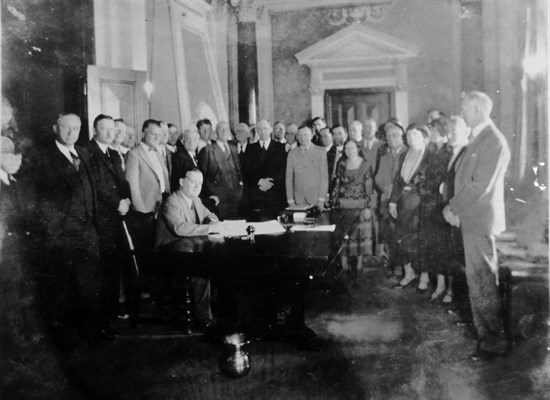
THE NORTH AMERICAN MODEL OF WILDLIFE CONSERVATION
As early settlers made their way West, North America's wildlife populations dwindled because of overexploitation (including market hunting) and habitat loss. Across the continent many species - elk, pronghorn, bison, and waterfowl included - went from countless numbers to just a few thousand by the close of the 19th century. Here in Mississippi, while it may be impossible for today's hunters to believe, populations of white-tailed deer, wild turkeys, and wood ducks almost disappeared from our woods and waters.
Beginning in the late 1800s, hunters and anglers such as Teddy Roosevelt realized they needed to set limits in order to protect rapidly disappearing wildlife and to assume responsibility for managing wild country. They pushed to establish the first hunting regulations and organized many conservation groups to advocate for the protection of wildlife habitat.
These early efforts were essential to the development of the North American Model of Wildlife Conservation, the only system of its kind in the world. The model's two basic principles are that our fish and wildlife belong to all North American citizens and are to be managed in such a way that their populations will be sustained forever. These basic beliefs are best explained through a set of foundational guidelines, best remembered as the Seven Sisters for Conservation:
- The Public Trust Doctrine. An 1842 U.S. Supreme Court opinion, in Martin v. Waddell, established the legal precedent that it was the government's responsibility to hold wild nature in trust for all citizens. The next three pillars reflect this fundamental doctrine.
- Democratic Rule of Law. Wildlife is allocated for use by citizens through laws. This protects against the rise of elites who would appropriate wildlife to themselves (as occurred in Europe). All citizens can participate, if necessary through the courts, in developing systems of wildlife conservation and use.
- Opportunity for All. In Canada and the United States, every man and woman has a fair and equitable opportunity under the law to participate in hunting and fishing. No one group, hunters or nonhunters, can legally exclude others from access to fame within the limitations of private property rights.
- Commercial Use. Hunters and anglers led the effort to eliminate markets and commercial traffic in dead animal parts, which was a huge business in the latter half of the 1800s and the early 1900s. The market killing of birds and animals decimated many species, bringing some to near extinction and others to extinction.
- Legitimate Use. Although laws could govern access to wildlife and ensure that all citizens had a say in its protection, there had to be guidelines as to appropriate use. This is defined as killing for food or fur, self-defense, and property protection, categories that are broadly interpreted.
- Science and Wildlife Policy. Interest in science and natural history was deeply ingrained in North American society, a fact reflected in the emphasis placed on recording wildlife habits and diversity by almost every major expedition charged with mapping the continent, along with the enormous popularity of amateur natural history collections. Hunters and anglers are, by habit and inclination, naturalists. Science is identified as a crucial requirement of wildlife management. For this Aldo Leopold, in his 1930 American Game Policy, credited Theodore Roosevelt, explicitly stating that science should be the underpinning of wildlife policies.
- International Wildlife Migratory Resources. The boundaries of states and nations are of little relevance to migratory wildlife and fish, and policies and laws for wildlife conservation have to address this reality. The Migratory Bird Treaty Act of 1918 is an excellent example of successful international cooperation.
The North American Model's comprehensive conservation principles and their scientific foundation resulted in the professional management of hunting and conservation programs. Today, it is still the hunters and anglers that support the conservation efforts that benefit wildlife populations and habitats in support of our uniquely successful conservation model. As a result, hunting and non-hunting wildlife access is now available to citizens of all social classes in the United States and Canada, something that we should be proud of and that is found nowhere else in the world!
Text courtesy of the Council to Advance Hunting and the Shooting Sports









